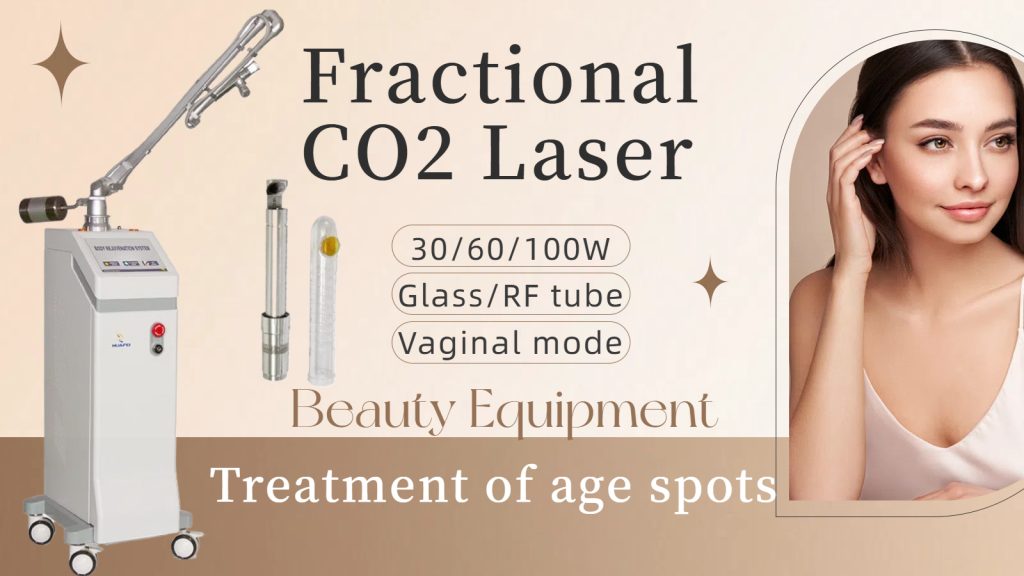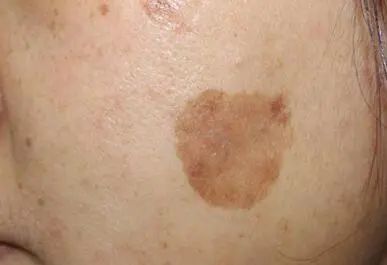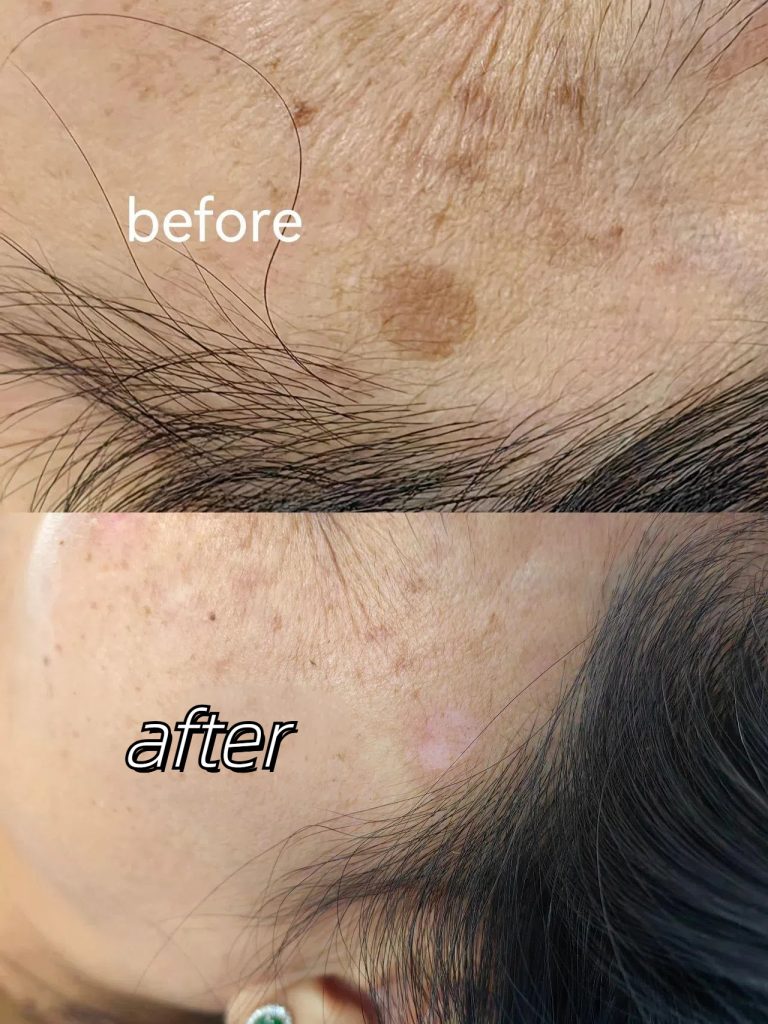Article source: https://www.litonlaser.com/how-does-fractional-co2-laser-treatment-fade-age-spots/
Age spots are one of the common pigment spots. There are many ways to treat age spots, including IPL machines, Q-switched lasers, picosecond lasers, and CO₂ fractional lasers.
Today, let’s talk about how to use fractional CO₂ lasers to fade age spots, and what mode is more suitable?
 Fractional CO2 laser treatment
Fractional CO2 laser treatment
1. What are age spots?
Age spots are also called seborrheic keratosis. The causes may be related to sun exposure, chronic inflammatory stimulation, etc. They are closely related to premature aging. They are caused by excessive fatigue and excessive damage to brain meridians and cells and appear on the surface. They are prone to occur on the face, back of the hands, chest, back, etc. In the early stage, there are one or more flat papules of light yellow or light brown, with a smooth surface and clear boundaries; in the later stage, they gradually increase, bulge, and thicken, and the color becomes darker, showing dark brown or even black papules or plaques. The surface may show mild papilloma-like hyperplasia, with a slow course and no tendency to heal.
The so-called “age spots”, the medical name is: seborrheic keratosis, which is a benign disease. It is the most common benign epidermal proliferative tumor in the elderly, and the elderly suffer from this damage to a greater or lesser extent.
Seborrheic keratosis is common on the face, back of the hands, chest and back, and can also be seen on other parts of the body such as the limbs. It generally affects the appearance and image. Once encountered, it is difficult to eliminate them with ordinary methods.

2. What is fractional CO2 laser?
Fractal CO2 laser is a gas laser that uses C0₂ gas as a working medium to generate laser; the fractional laser is the output mode of the laser. After focusing the laser of a specific infrared wavelength, the laser forms small irradiation points with intervals through computer control and automated mechanical technology, and normal skin tissue is retained between each irradiation point.
The working principle of CO₂ fractional laser is focal photothermolysis and stimulating regeneration effect. The wavelength is 10600nm, the target color base is water, and it belongs to the category of micro-exfoliation-exfoliation treatment. It has anti-aging and wrinkle removal, treatment of moderate to severe acne, large pores, auxiliary treatment of age spots, freckles, auxiliary treatment of sunken scars and hypertrophic scars, assisting in the treatment of alopecia areata, and enhancing product absorption.
CO2 fractional laser is an ablative fractional laser with a high water absorption coefficient. When the laser acts on the skin, the epidermis quickly generates high temperature and heat, causing the epidermal tissue to quickly heat up and vaporize, resulting in a white frost reaction on the epidermis. Its skin effect is mainly the epidermal-dermal effect, which stimulates collagen regeneration for a long time and has good long-term effects. There is a scab formation period and downtime period of about 5-7 days. If the repair is not in place, it is easy to cause pigmentation and sensitivity.
3. Can fractional CO2 laser treat age spots?
The carbon fractional laser treatment machine uses laser light of a certain wavelength to produce vaporization, coagulation, and thermal effects on the skin. According to the localized photothermal effect, it can stimulate the proliferation and reorganization of collagen, thereby treating age spots.
The treatment method is simple and fast, less painful, has significant curative effect, has little or no bleeding, few adverse reactions such as postoperative infection, and the wound heals quickly and generally leaves no scars.
When treating “age spots”, the operator only targets the parts that can be operated and will not cause damage to the surrounding skin. Before treatment, you only need to apply local anesthetic and wait for 30 minutes. After treatment, the repair effect will be better when combined with a medical mask!
4. Things to know before age spots treatment.
4.1 Make a clear diagnosis.
Middle-aged and elderly people often have a variety of skin tumors similar to age spots on their faces, such as basal cell carcinoma, squamous cell carcinoma, malignant melanoma and other malignant tumors; Bowen’s disease, solar keratosis and other precancerous lesions. Therefore, when “spots” appear on the face or certain parts of the body, you should go to the dermatology department of a regular hospital. It is important to make a clear diagnosis and obtain a pathological diagnosis if necessary.
4.2 Avoid contraindications.
Middle-aged and elderly people with serious cardiovascular and cerebrovascular diseases should inform their doctors, who will decide whether to use laser after comprehensively evaluating the risks.
5. Introduction to the method of fractional CO2 laser treatment for fading age spots.
5.1 Introduction to the theory of treatment of age spots.
CO2 fractional laser, with a wavelength of 10600nm, is an ablative fractional laser. Carbon dioxide lasers are generally equipped with two modes, namely, fractional mode and cutting mode. The fractional mode is to form small irradiation points with intervals through computer control and automated mechanical technology, and normal skin tissue (skin bridge) is preserved between each irradiation point. These normal tissues assist the damaged skin tissue in repair and regeneration, and are not prone to persistent erythema and scars. Therefore, its subsequent adverse reactions are less and recovery is faster. The fractional mode can form a large number of tiny heat accumulation areas on the skin, which will cause thermal coagulation of proteins and vaporization of water, shrink and denature dermal collagen, stimulate collagen proliferation, and improve skin problems such as acne, depressed scars, enlarged pores, photoaging, and age spots.
5.2 Principle of CO2 laser cutting mode.
The cutting mode can be used for grinding treatment of warts, moles, and other vegetation, age spots, and hypertrophic scars. The repetitive pulse mode is commonly used for mole removal and wart removal. It is a series of laser pulses with pauses and intervals in between, which is a bit like the sub-pulse light output of IPL. It is easy for novices to control and is not easy to burn the skin. The depth of tissue vaporization and peeling can be controlled. The light output can be stopped by releasing the foot pedal. CO2 laser has automatic hemostasis during the cutting process, with only low tissue carbonization and damage, and few side effects. Some doctors and operators also like to use the ultra-pulse mode to cut vegetation. The ultra-pulse mode refers to an output mode with a pulse width of less than 2ms. It has a very fast vaporization speed, precise range and depth of action, less thermal damage to the skin, and little tissue charring. It cuts the vegetation tissue through rapid vaporization, but due to its fast vaporization and cutting speed, it is difficult for novices to control.
5.3 Detailed treatment methods for treating age spots.
The fractional mode and cutting mode of CO2 laser are both effective in fading age spots. We can choose different treatment modes according to the different stages and forms of age spots. In the early stage of age spots, when they are in the state of flat papules, fractional mode can be used for treatment. The point spacing can be appropriately denser, using a point spacing of 0.6-0.8mm. The single-point energy is slightly higher than that of facial anti-aging, and can be overlapped once. When age spots are already in a state of raised keratinization, the cutting mode can be used first, and the age spots can be cut and ground like pigmented nevi. It can also be combined with the dot matrix mode. First, the part that protrudes from the skin surface is ground flush with the skin using the cutting mode, and then scanned and covered with the dot matrix mode. Strict repair is required after CO2 fractional laser surgery, and type III collagen and growth factors are used to promote the skin to complete epithelialization (epidermal repair) as soon as possible.

6. Postoperative care for laser treatment of age spots.
6.1 Short-term maintenance.
- After laser treatment, scabs will form for 1-2 weeks. Keep dry and avoid drinking during this period, and wait for natural scab detachment.
- Try not to get the wound wet and keep it dry for 1 week after surgery.
- Apply ointment to promote wound healing and prevent infection. The drug should not be applied too thickly.
6.2 Long-term maintenance.
- After the wound scabs, do not remove the scabs.
- Pay attention to sun protection. Before the scabs fall off, choose physical sun protection such as umbrellas and hats. After the scabs fall off, you can apply sunscreen (choose products with SPF ≥ 30), and do not expose to the sun.
- Strengthen sun protection after scab detachment to minimize the degree of post-inflammatory pigmentation. Generally, pigmentation will appear 1-2 months after treatment, and gradually recover in about half a year.
7. How to choose fractional CO2 laser?
Treating age spots is just one of the many functions of fractional CO2 laser. CO2 fractional laser can also treat various benign superficial skin tumors such as skin growths, flat warts, filiform warts, condyloma acuminatum, seborrheic keratosis, facial xanthoma, etc.; various acne pits, acne marks; various scars (such as trauma scars, burn scars, suture scars); age spots, various pigmented moles, etc.
So how do we choose a suitable CO2 laser? As a manufacturer with 9 years of experience in beauty technology training and 20 years of beauty machine manufacturing, Litonlaser can tell you the answer!
7.1 Laser power.
The power of fractional CO2 laser is the most important! Because this determines the size of the energy and the speed of the treatment time. Litonlaser’s CO2 laser power is available in 30 watts, 60 watts and 100 watts. We recommend that for ordinary skin rejuvenation and anti-aging, 30 watts can be used. This is the common power suitable for most novices.
If you are a doctor who pursues treatment and wants to cut various skin growths, then we recommend using 60W CO2 laser. This power is relatively strong and requires proficiency in the machine to achieve perfect treatment. It is not recommended for novices.
100-watt CO2 laser belongs to the super proficient level. Generally speaking, it is not needed. It is more inclined to surgical treatment. For ordinary cosmetic treatment, such high power is not required. It is recommended that you need to undergo our special training and use it only after you are sure to master it.
7.2 Type of laser tube.
Our common CO2 fractional laser has two laser tube options, glass tube and radio frequency (RF) tube. These different types of tubes have an impact on the light output and service life of the machine. Under normal circumstances, the service life of the glass tube fractional CO2 laser machine is usually 5 years, but the service life of the RF tube CO2 fractional laser can reach 10 years or even longer.
Under normal circumstances, we recommend that if the budget is sufficient, use the RF tube CO2 laser machine, not only the energy is more stable, the light output is more uniform, and the use is longer, but also for safety, the RF tube will be safer.
If you need more information about medical machines and beauty training, you can always contact us: https://www.litonlaser.com/.





Comments